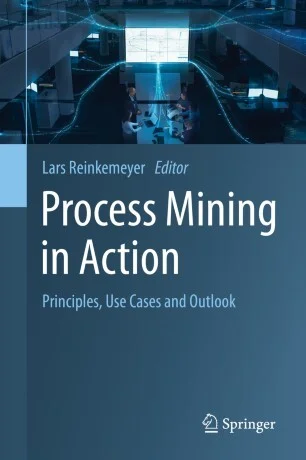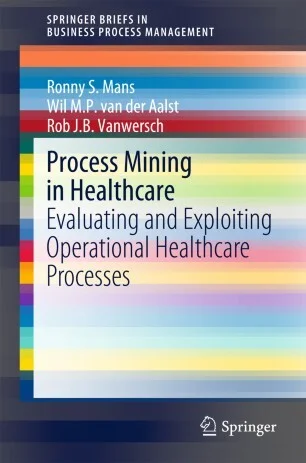
This is the second edition of Wil van der Aalst’s seminal book on process mining, which now discusses the field also in the broader context of data science and big data approaches. It includes several additions and updates, e.g. on inductive mining techniques, the notion of alignments, a considerably expanded section on software tools and a completely new chapter of process mining in the large. It is self-contained, while at the same time covering the entire process-mining spectrum from process discovery to predictive analytics.
After a general introduction to data science and process mining in Part I, Part II provides the basics of business process modeling and data mining necessary to understand the remainder of the book. Next, Part III focuses on process discovery as the most important process mining task, while Part IV moves beyond discovering the control flow of processes, highlighting conformance checking, and organizational and time perspectives. Part V offers a guide to successfully applying process mining in practice, including an introduction to the widely used open-source tool ProM and several commercial products. Lastly, Part VI takes a step back, reflecting on the material presented and the key open challenges.
Overall, this book provides a comprehensive overview of the state of the art in process mining. It is intended for business process analysts, business consultants, process managers, graduate students, and BPM researchers.
- First book on process mining, bridging the gap between business process modeling and business intelligence and positioning process mining within the rapidly growing data science discipline
- This second edition includes over 150 pages of new material, e.g. on data quality, the relation to data science, inductive mining techniques and the notion of alignments
- Written by one of the most influential and most-cited computer scientists and the best-known BPM researcher
- Self-contained and comprehensive overview for a broad audience in academia and industry, including up-to-date information on tools and the exploitation of modern IT infrastructures
Visit this to follow the Coursera MOOC "Process Mining: Data science in Action" . This online course is based on the book and is free. The course is running on the ondemand platform of Coursera and can be taken at any point in time.
The course explains the key analysis techniques in process mining. Participants will learn various process discovery algorithms. These can be used to automatically learn process models from raw event data. Various other process analysis techniques that use event data will be presented. Moreover, the course will provide easy-to-use software, real-life data sets, and practical skills to directly apply the theory in a variety of application domains.
This course is aimed at both students and professionals. A basic understanding of logic, sets, and statistics (at the undergraduate level) is assumed. Basic computer skills are required to use the software provided with the course (but no programming experience is needed). Participants are also expected to have an interest in process modeling and data mining but no specific prior knowledge is assumed as these concepts are introduced in the course.

The Process Mining Handbook is the book that accompanies the lectures at the Process Mining Summer School in Aachen. The recent and very fast development of the field, both academically and in commercial and industrial applications, highlighted the need for a new summary of the state of the art of the numerous different disciplines that compose process mining. The Process Mining Handbook aims to offer a clear image of the process mining techniques of today, and to set the path forward for the innovations in process sciences of the 2030s. It follows a sequence of milestones in the discipline, beginning with the foundation of the IEEE Task Force on Process Mining , the establishment of the XES standard , the publication of the Process Mining Manifesto , and the creation of the International Conference on Process Mining (ICPM) series.
The book is co-authored, among others, by the speakers of the Summer School. It is published by Springer, in the book series Lecture Notes in Business Information Processing (LNBIP).

More and more information about business processes is recorded by information systems in the form of so-called “event logs”. Despite the omnipresence of such data, most organizations diagnose problems based on fiction rather than facts. Process mining is an emerging discipline based on process model-driven approaches and data mining. It not only allows organizations to fully benefit from the information stored in their systems, but it can also be used to check the conformance of processes, detect bottlenecks, and predict execution problems.
Wil van der Aalst delivers the first book on process mining. It aims to be self-contained while covering the entire process mining spectrum from process discovery to operational support. In Part I, the author provides the basics of business process modeling and data mining necessary to understand the remainder of the book. Part II focuses on process discovery as the most important process mining task. Part III moves beyond discovering the control flow of processes and highlights conformance checking, and organizational and time perspectives. Part IV guides the reader in successfully applying process mining in practice, including an introduction to the widely used open-source tool ProM. Finally, Part V takes a step back, reflecting on the material presented and the key open challenges.
Overall, this book provides a comprehensive overview of the state of the art in process mining. It is intended for business process analysts, business consultants, process managers, graduate students, and BPM researchers.
- First book on process mining, bridging the gap between business process modeling and business intelligence.
- Written by one of the most influential and most-cited computer scientists and the best-known BPM researcher.
- Self-contained and comprehensive overview for a broad audience in academia and industry.
- The reader can put process mining into practice immediately due to the applicability of the techniques and the availability of the open-source process mining software ProM.
These slides should not be used without referring to the book and www.processmining.org.
A collection of event logs and process models illustrating the various concepts can be found in a zip file. An explanation of these artifacts and their relation to the book can be found here. Note that it is assumed that the reader has installed ProM 6 (and/or ProM 5.2). the various concepts can be found in a zip file. An explanation of these artifacts and their relation to the book can be found here. Note that it is assumed that the reader has installed ProM 6 (and/or ProM 5.2).







